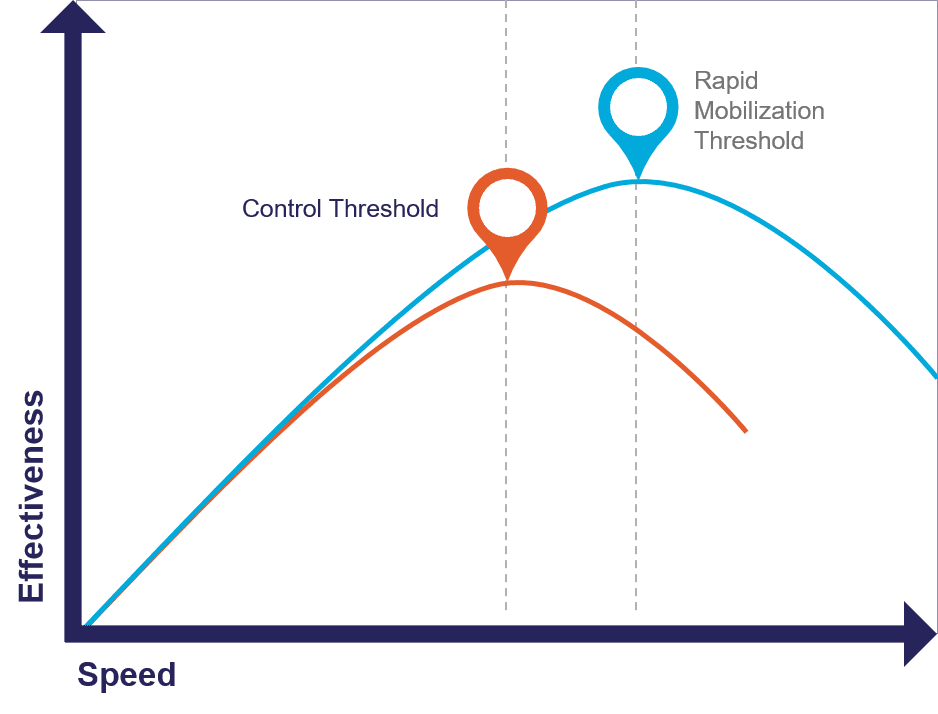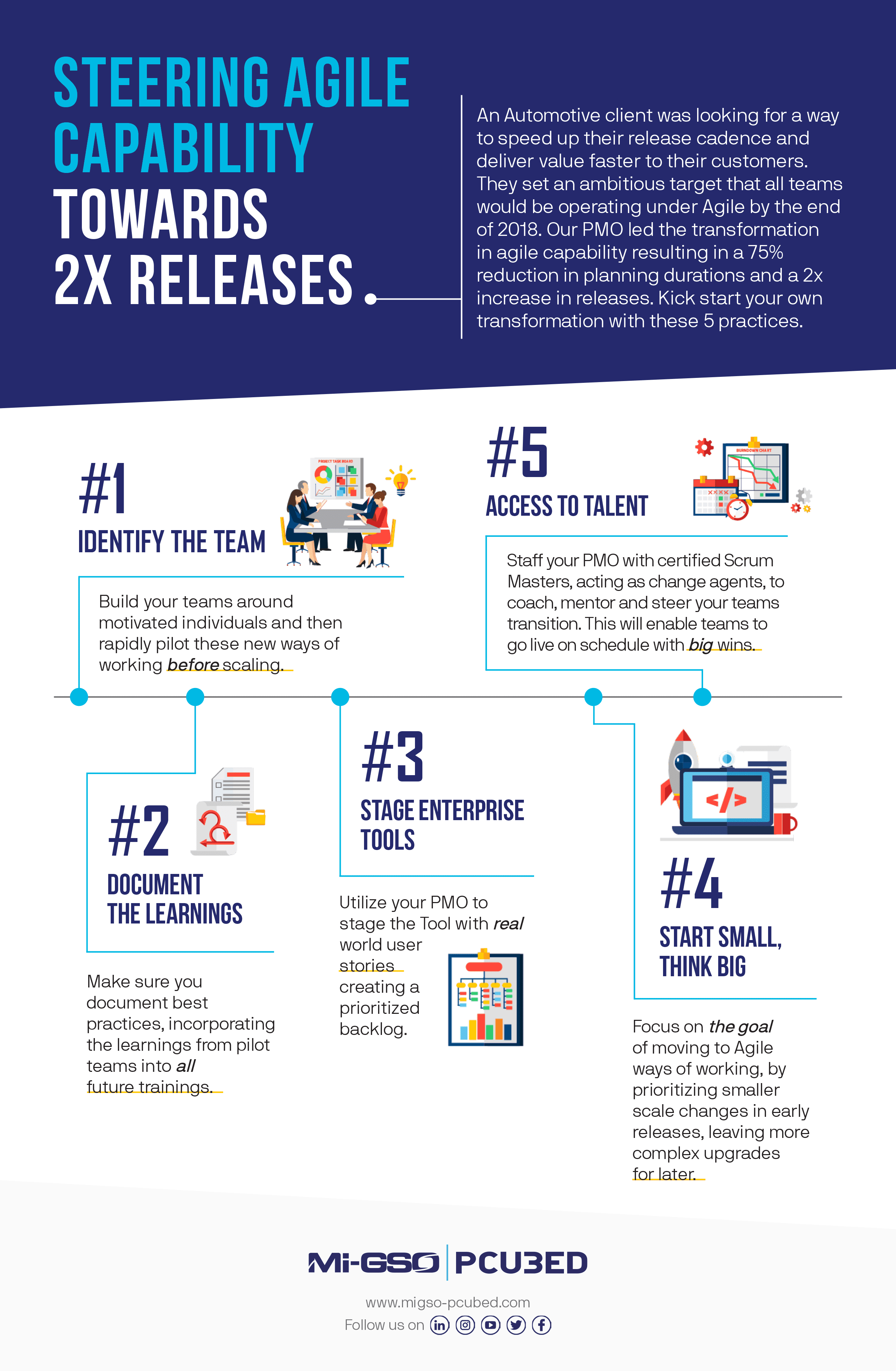Our website is not supported on this browser
The browser you are using (Internet Explorer) cannot display our content.
Please come back on a more recent browser to have the best experience possible

MIGSO-PCUBED originally began working with our client, a leading Automotive OEM, to increase validation software tool adoption and user satisfaction across their engineering community. With a large backlog of product enhancements and lengthy planning timelines, the organization was looking for a way to speed up its release cadence and deliver value faster to their customer.
Although business teams had transitioned to Agile in pockets, waterfall delivery was still the primary method for IT. To address, our client set an ambitious target that all teams would be operating under Agile by the end of 2018.
Although the client had assigned Agile trained coaches and trained teams in Agile methodology, they were not seeing the immediate benefits they had expected.
We at MIGSO-PCUBED understand that Business Agility is more than deploying the latest Agile software methods. It is the organizational, cultural and mind set flexibility to get products to market faster, increase value to customers and increase profitability.

Yet beyond a certain point, the capability of the organization in terms of skills, experience, leadership and process cannot support a greater speed.
Rather than going big bang, MIGSO-PCUBED recommends reviewing all inhibitors to increasing agility and systematically identifying which change management techniques and tools can be used to address those challenges.
In this case, the PMO set out to improve the transition to the Agile state, getting the balance right between speed and effectiveness. The team’s success was characterized by 5 key practices across people, process, tools, governance and organizational leadership & culture.
Want to know more about Agile Transformations?
Check out our Podcast on Implementing Agile.

Utilizing a foundational Agile principle, “building projects around motivated individuals”, the PMO quickly engaged with the team who had raised their hands first. They brainstormed ways to unblock their too slow and traditional delivery approaches and frameworks and began implementing immediately.
During the first quarter of 2018, the pilot team rapidly introduced and validated new ways of working, with the freedom to “fail fast”, constantly refining and making changes to be more effective as a team.
Rapidly introduce and validate new ways of working before scaling at the enterprise level.
As highlighted above, the PMO understood that getting the balance right between speed and effectiveness was crucial to the success of the Agile transformation. Therefore, they focused on short iterations, piloting new ways of working within their finite team and adjusting their behaviors prior to rolling out across the entire department.
During the pilot, the PMO facilitated the development of best practices, documenting the learnings which were then broadcast during each of the weekly meetings to the wider team. The learnings were then incorporated into Agile processes, used as a basis for training as the teams lived continuous improvement.
The first team transitioned to an Agile way of working in January 2018, and within 3 short months the remaining 5 teams transitioned together.
An additional inhibitor to enterprise agility was the limited use of Agile based tools for increment planning and development management.
Tool enhancement change requests were previously managed in an on-line database. Some business community teams had recently transitioned to JIRA and CA Agile Central software tools with success. The PMO, deciding to build upon that momentum, took the lead in staging CA Agile Central with user stories to further the transition to Agile and replace the previous outdated tracking software.
Previous customer experience optimization had reduced the change requests from 2000 down to 800, however to meet the tight timing, the PMO needed to accelerate the creation of a prioritized backlog. Starting small with a backlog of 40 user stories allowed the team to stage the Enterprise Management Tool with real world information and kick off the Agile transition launch within the tight window. After that initial start, the team took on the significant task of transitioning the remainder of the backlog into CA Agile Central.
The primary goals of the team’s transition to Agile was to reduce the lengthy planning durations and to speed up the release delivery cadence. As a result, the organization decided to move to quarterly releases and set up the minimum viable governance required to get tool enhancements to the user community faster. The team needed to start small yet think big; a common theme across the people, process, tools and organizational practices.
Start small, think big.
By using a more detailed prioritization tool, the team was able to give precedence to the highest priority user stories for the next quarterly release, meeting their goals, while meeting the IT team’s needs as well.
Finally, in the days leading up to the launch, the team arranged another round of training in Agile techniques. This allowed the teams to have a common vision and understanding of how they would be working and their roles in the new agile framework. This, along with a Program Increment Planning session, set the foundational structure required to run at speed for the iteration. PI Planning and coupled with the additional training allowed the teams to come together quickly, putting what they had adapted during the pilot phase into practice, so that they could operate with efficiency during the next iteration.
The final piece of the organization’s success was access to skilled resources. An Agile coach was assigned to the organization. In addition, the PMO was staffed with Certified Scrum Masters, acting as change agents to coach, mentor and steer the teams’ transition to Agile, enabling all 6 teams and 14 workstreams to go live way ahead of schedule.
With the improvement in Agile capability, the organization is seeing wins. Early adopters are communicating the value of going to an Agile way of working, while also communicating the latest enhancements with the tool; the first of which went to UAT in June and live to the user base at the end of June.
In addition, by scaling the Agile transformation based on the capability of the organization and adjusting where needed, all teams are now operating in an Agile fashion. The client has reduced planning durations by 75% and increased the frequency of releases 2x.

Looking to kick start your own Agile transformation, contact the team to discuss Agile acceleration workshops and Engineering Agility certification training for your organization. Or for additional reading, check out our article on 5 key take-aways to implement Change Management to drive agility.
Loved what you just read?
Let's stay in touch.
No spam, only great things to read in our newsletter.
We combine our expertise with a fine knowledge of the industry to deliver high-value project management services.
MIGSO-PCUBED is part of the ALTEN group.
Find us around the world
Australia – Canada – France – Germany – Italy – Mexico – The Netherlands – Portugal – Romania – South East Asia – Spain – Switzerland – United Kingdom – United States
© 2024 MIGSO-PCUBED. All rights reserved | Legal information | Privacy Policy | Cookie Settings | Intranet
Perfect jobs also result from great environments : the team, its culture and energy.
So tell us more about you : who you are, your project, your ambitions,
and let’s find your next step together.
Dear candidates, please note that you will only be contacted via email from the following domain: migso-pcubed.com. Please remain vigilant and ensure that you interact exclusively with our official websites. The MIGSO-PCUBED Team
Choose your language
Our website is not supported on this browser
The browser you are using (Internet Explorer) cannot display our content.
Please come back on a more recent browser to have the best experience possible
